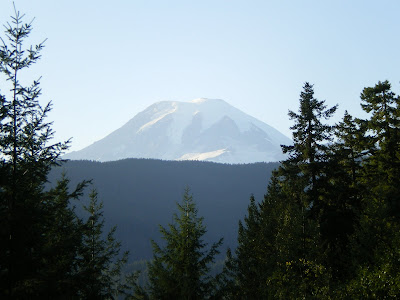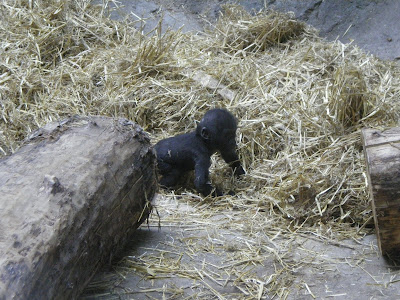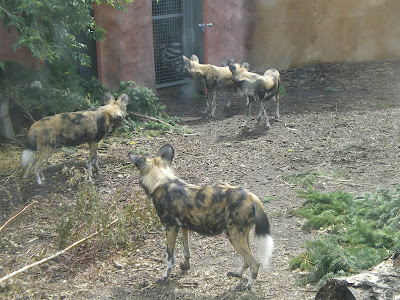Mt. St. Helens and onwards to the coast
Garrett and I made our first camping breakfast the next morning. Again, we were a little unskilled, but figured it out eventually. The main problem we had was that the propane bottle we were using turned out to be almost empty, and we didn't realize it until we had tried to cook for about 20 minutes. After replacing it with a new bottle, our cooking speed improved and we polished off our breakfast of eggs, bacon and hashbrowns.
By 10am, we were packed up and on the road again, on our way to Mt. St. Helens. The Mt. St. Helens National Volcano Monument is found within the Gifford Pinchot National Forest. The road towards the mountain is long and winding, but quite scenic. We took our first pictures while still quite a distance away from the volcano, but you can clearly see the swath of mud that flowed down from the explosion 28 years ago. This stretch used to be the Toutle River, but it was basically completely buried.
 Mt. St. Helens was shook by a magnitude 4.5 earthquake on March 20th 1980. This event destabilized the volcano, and steam started pouring out of the mountain. In addition, the north side of the mountain started to bulge over the course of the next month. Almost 2 months after the initial earthquake, on May 18th, a second, magnitude 5.1 earthquake again rocked the volcano, causing a massive collapse of the north face of the mountain. The below pictures shows me to the northwest of the volcano.
Mt. St. Helens was shook by a magnitude 4.5 earthquake on March 20th 1980. This event destabilized the volcano, and steam started pouring out of the mountain. In addition, the north side of the mountain started to bulge over the course of the next month. Almost 2 months after the initial earthquake, on May 18th, a second, magnitude 5.1 earthquake again rocked the volcano, causing a massive collapse of the north face of the mountain. The below pictures shows me to the northwest of the volcano. The collapse of the north side created a huge landslide down the side of the mountain, and was immediately followed by a huge explosion out the side of the volcano. This lateral explosion was a unique event in volcanology, since a lateral explosion had never been documented before. The data and evidence from the Mt. St. Helens' explosion helped explain some bizarre geology around other volcano structures around the world. This explosion caused pyroclastic flows, which consisted of hot gas and rock traveling along at speeds of 80km/hr.
The collapse of the north side created a huge landslide down the side of the mountain, and was immediately followed by a huge explosion out the side of the volcano. This lateral explosion was a unique event in volcanology, since a lateral explosion had never been documented before. The data and evidence from the Mt. St. Helens' explosion helped explain some bizarre geology around other volcano structures around the world. This explosion caused pyroclastic flows, which consisted of hot gas and rock traveling along at speeds of 80km/hr. The lateral explosion instantly vaporized the glacier that was on the top of Mt. St. Helens, creating millions of tons of water that mixed with the landslide and swept down the mountain and away. This mudflow ran down the Toutle river for miles, as seen in the first picture above.
The lateral explosion instantly vaporized the glacier that was on the top of Mt. St. Helens, creating millions of tons of water that mixed with the landslide and swept down the mountain and away. This mudflow ran down the Toutle river for miles, as seen in the first picture above. Subsequently, the volcano began pumping millions of tons of rock and gas into the air, creating a plume 20 to 27 km high. The devastation from the explosion was widespread, and 57 people in the proximity of the mountain were killed. As well, it is estimated that 7000 big game and 12 million fish from a hatchery were also killed. Lastly, 200 homes were destroyed or extensively damaged.
Subsequently, the volcano began pumping millions of tons of rock and gas into the air, creating a plume 20 to 27 km high. The devastation from the explosion was widespread, and 57 people in the proximity of the mountain were killed. As well, it is estimated that 7000 big game and 12 million fish from a hatchery were also killed. Lastly, 200 homes were destroyed or extensively damaged. The landscape was devastated for over 630 square kilometers, and much of it remains barren nowadays.
The landscape was devastated for over 630 square kilometers, and much of it remains barren nowadays.

 There is a large area of the devastation zone that was repopulated with fir trees, however it is quite unnatural looking because all of the trees are identical in size and type.
There is a large area of the devastation zone that was repopulated with fir trees, however it is quite unnatural looking because all of the trees are identical in size and type. Before the explosion, Mt. St. Helens was the fifth largest mountain in Washington, at a height of 1525m. After the explosion, it lost 400m of peak and was left with a crated 3.2km wide and 800m deep. This is what the mountain looked like before when it was called "Mount Fuji of America":
Before the explosion, Mt. St. Helens was the fifth largest mountain in Washington, at a height of 1525m. After the explosion, it lost 400m of peak and was left with a crated 3.2km wide and 800m deep. This is what the mountain looked like before when it was called "Mount Fuji of America": And here it is after the explosion:
And here it is after the explosion: It looks like half the mountain was blown away! The crater has even filled in over the years from continual magma spewing. Plus, a whole new glacier has formed within the crater, creating the newest glacier on earth.
It looks like half the mountain was blown away! The crater has even filled in over the years from continual magma spewing. Plus, a whole new glacier has formed within the crater, creating the newest glacier on earth. Garrett and I drove out to the Johnston Ridge Observatory to learn all about the explosion and take in the view. The day was sunny and clear, if a little hazy, but since the volcano creates much of the haze from the steam is pumps out, there wasn't much to be done about it.
Garrett and I drove out to the Johnston Ridge Observatory to learn all about the explosion and take in the view. The day was sunny and clear, if a little hazy, but since the volcano creates much of the haze from the steam is pumps out, there wasn't much to be done about it. Within the observatory, we got to see the seismographs that record any seismic activity in the crater:
Within the observatory, we got to see the seismographs that record any seismic activity in the crater:
 We saw the damage caused by the explosion on trees:
We saw the damage caused by the explosion on trees: We learned that when the volcano is more active than usual, they send in little spider probes to check out what's going on, rather than humans. This is a good idea, since this little guy (below) got exploded during his trip:
We learned that when the volcano is more active than usual, they send in little spider probes to check out what's going on, rather than humans. This is a good idea, since this little guy (below) got exploded during his trip: After touring the observatory, we sat through a brief movie about the explosion and then read some of the survivor's stories. These in themselves were so interesting - some people had truly amazing stories about surviving the explosion. After taking a few more pictures, we ate some lunch in the parking lot before heading back out of the park.
After touring the observatory, we sat through a brief movie about the explosion and then read some of the survivor's stories. These in themselves were so interesting - some people had truly amazing stories about surviving the explosion. After taking a few more pictures, we ate some lunch in the parking lot before heading back out of the park.
 The next phase of our trip involved driving through into Portland, Oregon, and then heading towards the western coast. We arrived at Lincoln City on the coast around 6pm, finding a nice campsite at the Devil's Head State Park. We made a hearty dinner of Kraft Diner and hotdogs, as well as some hot chocolate. Pretty good day, after all.
The next phase of our trip involved driving through into Portland, Oregon, and then heading towards the western coast. We arrived at Lincoln City on the coast around 6pm, finding a nice campsite at the Devil's Head State Park. We made a hearty dinner of Kraft Diner and hotdogs, as well as some hot chocolate. Pretty good day, after all.







































































